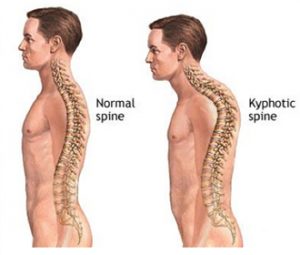 Hyperkyphosis (also often written as Hyper-Kyphosis) is an increasingly common condition, in which the body assumes a “head forward” posture. While mild kyphosis is often not seen as a serious condition, more severe Hyperkyphosis can significantly impact quality of life.
Hyperkyphosis (also often written as Hyper-Kyphosis) is an increasingly common condition, in which the body assumes a “head forward” posture. While mild kyphosis is often not seen as a serious condition, more severe Hyperkyphosis can significantly impact quality of life.
What is Hyperkyphosis?
When the spine and overall posture are viewed from the side, the ear, shoulder, hip, knee and ankle should all be in alignment. To enable optimal movement and absorption of forces whilst maintaining these positions in upright posture, the spine has a natural curvature, when viewed from the sides. In the neck (cervical spine) and lower back (lumbar spine) these curves are known as Lordosis, whilst in the mid-back (thoracic spine) the curve is called a Kyphosis. When these curves are increased beyond the average, the term “Hyper” is added to the start of them.
Thoracic kyphosis should normally be measured with an angle of less than 40°. When the kyphosis is greater than 45°, we describe the condition as Hyperkyphosis. Individuals with Hyperkyphosis appear to have a “rounded” or “hunchback” posture.
With gravity compressing us down hard at 9.8ms², our muscles have to work constantly to support our upright posture. When muscles are weak, it harder to resist this force and we tend to round our shoulders and jut our chin forward.
What causes Hyperkyphosis?
The causes of Hyperkyphosis are highly variable and depend on the time in life that they develop. They can be due either to postural factors, which means simply “poor posture” or they can be due to structural factors which involve an alteration to the shape of the thoracic vertebra causing them to become more wedged.
Wedging of thoracic vertebra can be caused by congenital vertebra malformations from birth, Scheuermann’s disease in adolescence, osteoporotic fractures in adulthood, thoracic compression fractures due to trauma and spinal tumours and infections.
How is Hyperkyphosis diagnosed?
Hyperkyphosis is typically diagnosed from a visual inspection, and its specific cause is determined though the use of X-rays. It is critical that X-rays are taken before treating Hyperkyphosis, as it is important to difference between a case caused by poor posture, or one in which vertebral malformation may be an issue.
What are the symptoms of Hyperkyphosis?
Hyperkyphosis is typically signified by noticeable postural changes.
Common signs and symptoms include:
• Rounding of the shoulders or a “hunchback” appearance
• The head is in front of the hips or pelvis when standing
• Mid-back aching and stiffness that often worsens with standing and eases when laying down
• Tenderness of the spine and surrounding muscles in the mid-back
• Tiredness after standing or repetitive bending
• In more severe cases difficulty breathing may develop as the lungs become compressed and indigestion, heartburn due to stomach compression
How is Hyperkyphosis treated?
Treatments for Hyperkyphosis vary depending on the cause of the condition.
In postural kyphosis in adults or children, where there is no structural reason for the kyphosis and the patient can be positioned into the correct upright posture, a consistent postural strengthening and re-training program will often be sufficient. It is essential that a specialist program is devised in order that exercises do not work counteractively, however.
In adult patients who are becoming more hunched forward, a specific spinal rehabilitative programme involving Chiropractic Biophysics can be performed to help strengthen the postural muscles, learn awareness of correct posture and stretch or traction the spine back towards upright posture.
In adults where pain and posture worsen when standing upright, a kyphobrace worn for periods throughout the day can help to ease discomfort and maintain upright posture.
In cases of Scheuermann’s disease, a condition where the deformity is progressing as the spine grows in adolescence, a Kyphobrace is often effective in improving the way the spine is growing when it is combined with a specific postural stretching strengthening programme.
When non-surgical treatment is not effective in treating Hyperkyphosis there are some surgical options available. In cases of vertebral compression fractures, kyphoplasty may be performed, it involves an injection of a type of cement into vertebral body to stop further collapse. Surgery may also be performed to straighten the spine, but it is not without significant risks and complications.


